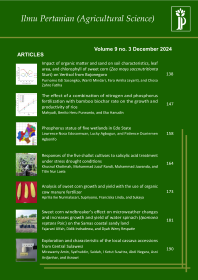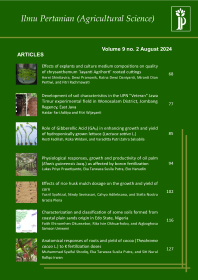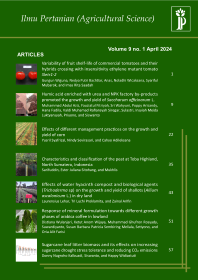Various Soil Types, Organic Fertilizers and Doses with Growth and Yields of Stevia rebaudiana Bertoni M
Dian Pratama Putra Saragih(1*), Azwar Ma'as(2), Soepriyanto Notohadisuwarno(3)
(1) Institut Pertanian Stiper, Yogyakarta
(2) Faculty of Agriculture Universitas Gadjah Mada, Yogyakarta
(3) Faculty of Agriculture Universitas Gadjah Mada, Yogyakarta
(*) Corresponding Author
Abstract
Stevia has several advantages including the level of sweetness that reaches 100-200 the sweetness of sugar cane and low calorie so that it is safe to be consumed by diabetics and obesity. The possibilities of plants to grow on soil properties and fertility become an important issue in agricultural cultivation systems and with the treatment of organic fertilizers will produce significant results in agricultural research. The experiments were arranged in Completely Randomized Design (CRD) with 3 various soil types of treatment factors: Alfisol (Al), Andisol (An) and Vertisol (Ve) soil with 2 types of organic fertilizer ie Compost (K) and Manure (SK) and 3 kinds of doses 20 ton/ha (12 g/pot), 40 ton/ha (24 g/pot) and 60 ton/ha (36 g/pot). Observational data were analyzed using variance analysis (ANOVA), if there was a real significant difference, the Duncan 5% real level to know the comparison between treatments. The results showed that the soil type of Vertisol given by compost fertilizer at 40 ton/ha (24 g/pot) gave the highest yield on all agronomic parameters, i.e. number of leaves, number of clumps, plant length, dry weight and wet weight. The result of production analysis shows that stevia at lowland can yield higher, on vertisol 2,7 ton/ha, alfisol 1 ton/ha and andisol 0,4 ton/ha whereas in highland that yield only 0,3 ton / ha (standard fertilizers) but with increasing amounts of biomass of stevia leaves can increase stevioside levels significantly.
Keywords
Full Text:
PDFReferences
Atmoko, M.A.B. 2001. Pemberian Gambut Rawa Pening pada Tanah Latosol untuk Meningkatkan Pertumbuhan dan Kandungan Gula pada Tanaman Stevia (Stevia rebaudiana Bertoni M.) [Essay]. Bogor: Fakultas Matematika dan Ilmu Pengetahuan Alam, Institut Pertanian Bogor.
Buana, L dan DH.Goenadi, 1985. Studi Tentang Korelasi Antara Pertumbuhan Dan Produksi Tanaman Stevia, Menara Perkebunan 53(3):68-71
Buol, S.W., Southhard, R.J., Graham. R.C. dan Mc Daniel, P.A. (2003). Soil Genesis and Classification. The Iowa State Univ. Press, Ames.
Djajadi, M. Sholeh, dan N. Sudibyo. 2002. Pengaruh Pupuk Organik dan Anorganik ZA dan SP 36 Terhadap Hasil dan Mutu Tembakau Temanggung Pada Tanah Andisols. Jurnal Littri. Vol.8. No.1.
Djajadi. 2014. Pengembangan Tanaman pemanis Stevia rebaudiana (Bertoni) di Indonesia. Perspektif Vol. 13 No. 1. 25 – 33.
Fanning, D.S. dan Fanning M.C.B (1989). Soil Morphology, Genesis and Classification. John Wiley. J Sons, Singapore.
Goenadi, D. H.1994. Peluang aplikasi mikroba dalam menunjang pengelolaan tanah perkebunan. Bioteknologi Perkebunan 1 : 17-22.
Goenadi DH. 1985. Pengaruh pupuk kandang, pupuk NPK, dan pupuk organik cair terhadap stevia. Menara Perkebunan 53:29-34.
Hanafiah, K. A.2014. Dasar – Dasar Ilmu Tanah. Rajawali Pers. Jakarta
Hardjowigeno S. 2003. Ilmu Tanah. Jakarta : Akademika : Pressindo.
Lemus – Mondaca, R.; A. Vega-Galves, L. Zura – Bravo, K. Ah – Hen. 2012. Stevia rebaudiana Bertoni, source of a high-potency natural sweetener: A comprehensive review on biochemical, nutrional and functional aspects. Food Chemistry 132: 11211132.
Ma’as, A. 1996. Ilmu Tanah dan Pupuk. Handout. Akademi Penyuluh Pertanian (APP) Yogyakarta. Yogyakarta.
Nursyamsi, D, S.M. Nanan, Sutisni and IPG. Widjaja-Adhi. 1996. Erapan P dan Kebutuhan Pupuk P Untuk Tanaman Pangan pada Tanah-tanah Asam. Pusat Penelitian Tanah dan Agroklimat Bogor. in Jurnal Tanah Tropika. Tahun II No.2.
Nuryani H.U., T. Notohadiningrat, R. Sutanto and B. Radjagukguk. 1993. Faktor Jerapan dan Pelepasan fosfat di tanah Andosol dan Latosol. Jurnal BPPS UGM: 6(4b).
Pala, P.K., R. Prasad, V. Pathaniaa. 2013. Effect of decapitation and nutrient applications on shoot branching, yield, and accumulation of secondary metabolites in leaves of stevia rebaudiana Bertoni. Journal of Plant Physiology 170:1526 1535.
Prawiranata, H., S. Harran and P. Tjondronegoro. 1990. Dasar – dasar fisiologi tumbuhan. Fakultas MIPA – IPB. Bogor. 339hal.
Rahayu, A., Utami, S. R., Prijono, S. 2015. The Changes of Soil Physical and Chemical Properties of Andisols as Affected by Drying and Rewetting Processes. Journal of Degraded and Mining Lands Management. Volume 3, No. 1, pp439 – 446.
Rina, D. 2015. Manfaat Unsur N, P, dan K Bagi Tanaman. Jakarta. Indonesia.
Rosmarkam, A. Yuwono, N. W. 2014. Ilmu Kesuburan Tanah. Penerbit Kanisius. Yogyakarta.
Shock, C. 1982. Experimental cultivation of Rebaudi’s stevia in California. University of California – Davis, Agronomy Progress Report, April pp.122.
Shoji, S., M. Nanzyo and R.A. Dahlgren (1993) Volcanic Ash Soils -Genesis, properties and Utilization. Developments in Soil Science 21, Elsevier, Amsterdam, pp.1-288.
Smarrt, J. 1992. Phaseolus vulgaris L. Bogor, Indonesia: Prosea Foundation.
Singh, S. And Rao, G. 2005. Stevia: The herbal sugar of 21st Century. Sugar Tech, 71:17 – 24
Sunarminto, B.H. Santosa. H. Daya Mengembang dan Mengerut Montmorillonit I: Pengaruh Intensitas Curah-Embun Terhadap Pengolaha Tanah Vertisol di Kecamatan Tepus dan Playen, Pegunungan Seribu Wonosari – Riset Laboratorium. AGRITECH, Vol. 28, No. 1
Syukur. M. 1996. Pengaruh Pemberian Lumpur Buangan dan Pengolahan Limbah Sintesis Antibiotika dan Pupuk Kandang terhadap Pertumbuhan dan Produksi Stevia (Stevia rebaudiana Bertoni M.) [Essay]. Bogor : Fakultas Pertanian, Institut Pertanian Bogor.
Tisdale, S.L., W.L. Nelson& J.D. Beaton. 1985. Soil Fertility and Fertilizers. MacMillan Pub. Co. New York.
Todd, J, and Glade, M. 2010. The Cultivation of Stevia, “Nature’s Sweetener”. Omafra. Ministry of Agriculture and Food. Ontario, Canada.
Article Metrics
Refbacks
- There are currently no refbacks.
Ilmu Pertanian (Agricultural Science) ISSN 0126-4214 (print), ISSN 2527-7162 (online) is published by Faculty of Agriculture Universitas Gadjah Mada collaboration with Perhimpunan Sarjana Pertanian Indonesia (PISPI) and licensed under a Creative Commons Attribution-ShareAlike 4.0 International License.













